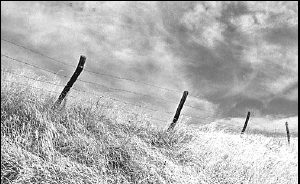
 "You sons of bitches," W.T.
boomed. "You sons of bitches," W.T.
boomed.
Long separated by a
fence line, a pair of mighty Simmental bulls had reconnected. They
tore into each other, heads clashing amidst the play of grunts,
dust and instinct. They were also rapidly undoing that fence line,
a 75-year-old defining line of wire and wood, a boundary we had
repaired only a week earlier.
Marlboro dangling
between weathered lips, W.T. slammed a dusty boot on the
accelerator and jammed the powder-blue, beater Ford
forward.
Wham !
The Ford rattled under the shock of impact. My head smacked the
dash, and W.T.'s smoke was now dancing around on the floor mat. The
bulls weren't fazed. Merely budged by the collision, they kept at
it. A line of wire snapped, a post was uprooted, and staples were
beginning to fly.
"Bastards," W.T. uttered, slamming the truck into reverse.
A second run had the desired effect. A ton of Ford buzzing at 40
mph smacked the Simmental with a pronounced thud .
After briefly considering taking on the truck, the bull fled, tail
between its legs. The other lost interest and returned to the realm
of appetite, seeking sex and grass.
The fence would
survive.
For obvious reasons, I
had been somewhat hesitant to join W.T. at the Mexican
Place.
A weathered, ancient
ranch hand, W.T. had the distinction of being known as an unsavory
character. He was a man who raised a goat to adulthood, treated the
animal like a house pet and then ate him. He happily lived on hard
work, cans of Budweiser and heavy women. Despite having ranched his
whole life, W.T. remained a hand at the age of 54.
Equally unsavory, the
Mexican Place, a mouse-infested, red, tar-paper shack high on the
upper ranch outside Norwood, had the distinction of being the only
building on Williams Ranches to be owned at one time by a Hispanic.
It was an ideal spot for W.T. to hole up for five
months.
I had little choice when
my boss David Williams barked: "You're going up to the Mexican
Place this summer. The fences up there are a mess, haven't been
mended going on 10 years. Maybe you'll learn something about
ranching this summer."
Armed with a tool belt,
a pair of fencing pliers, a claw hammer and a 17-year-old's limited
sensibilities, I set out cautiously.
Despite my apprehension,
it wasn't long before I started to groove into W.T., the Mexican
Place and the upper ranch. Rough appearances aside, W.T. was the
master of many forgotten arts. The Mexican Place was a suitable
hovel for cooking and crashing. And the upper ranch was an ideal
climate to practice those forgotten arts.
Holding one's liquor was
laboriously taught over glasses of Black Velvet and cans of
Budweiser at the Hitching Post. We worked on the art of the story
under epic Colorado skies on a makeshift bench in front of the
Mexican Place. Whipping up a palatable spread from canned goods and
a loaf of bread was a recurring theme. We dabbled in the handling
of horses and the wooing of women. And, our focus was on our
lifeblood, gaining a mastery of fencing, the craft of containing
cattle.
At first, fencing seems
basic, grunt work sink posts, stretch wire and connect the two with
staples. The cunning of it is much more subtle, an acquired
taste.
W.T. was an able master.
He never worked too quickly, always polished the job and set fence
that would last and withstand the undoing of cattle and the passage
of years. He invoked pride in a simple keeping of boundaries,
instilled passion in holding an operation together. His time on the
line was time spent deep in thought. Words were rarely
exchanged.
During the course of
work on nearly a hundred miles of barbed wire, we frequently bumped
into testimony of the Williams family's enduring legacy antique
wire and weathered posts likely hung by the original homesteader.
And W.T. and I had been invited to be the new stewards, welcomed to
walk the same line and take the same swings. Day after day, we hit
those fence lines and contributed our own brand of
craftsmanship.
As the summer drew to an
end and the first signs of fall hit, I shook hands with W.T. a
final time and bid farewell to the Mexican Place. Departing, I
could sink a staple with one swing, hand dig a post hole in a few
minutes, easily splice and stretch wire, and place a stout and
proud edge on any kind of acreage.
I also left with an
understanding that time has no place along the fence line and a
sense that long-standing work stands tallest. After those many
months, I also finally realized that W.T. was no failure. The man
had strong sense and remained a hand for a reason. He knew a
comfortable simplicity. Truly, good story, cans of beer, an
occasional taste of goat and slow but steady work along a fence
line are fine ways to wile away the years.
-Will Sands
|

